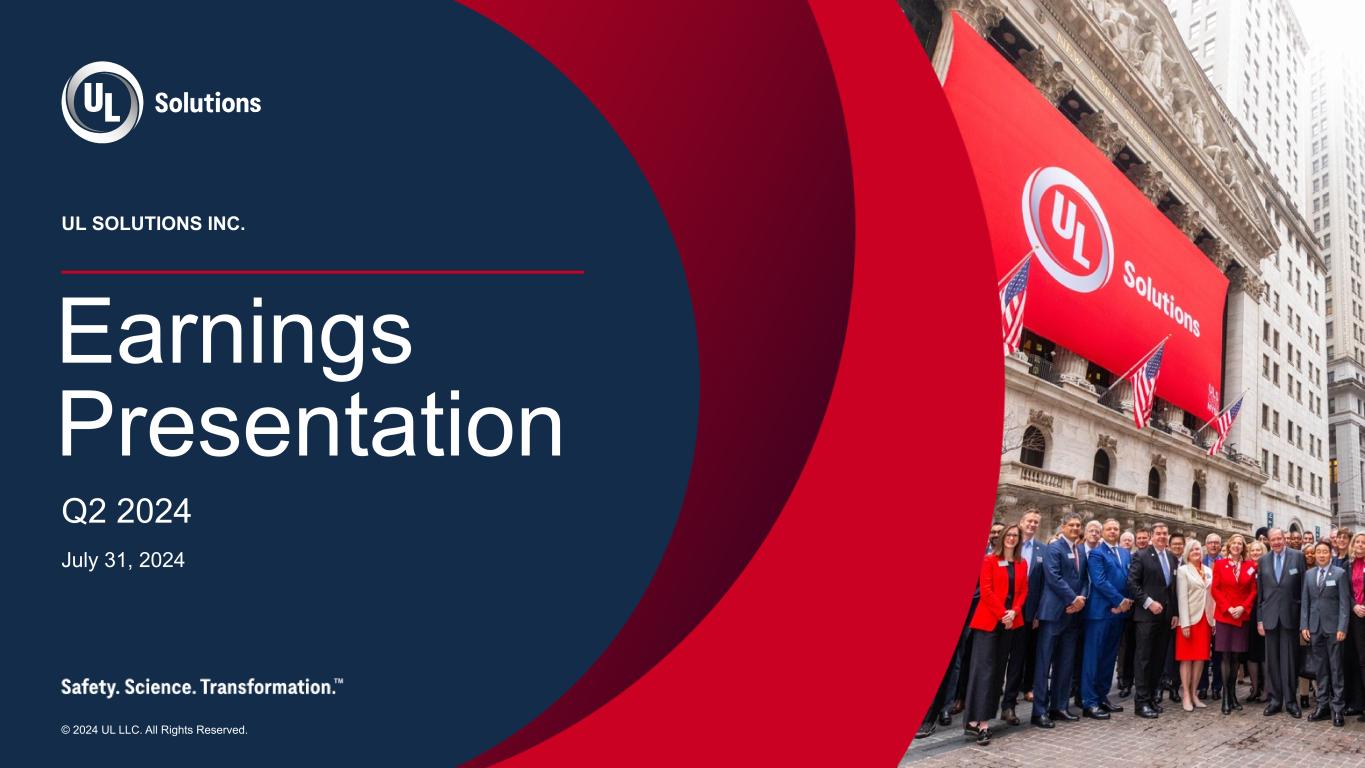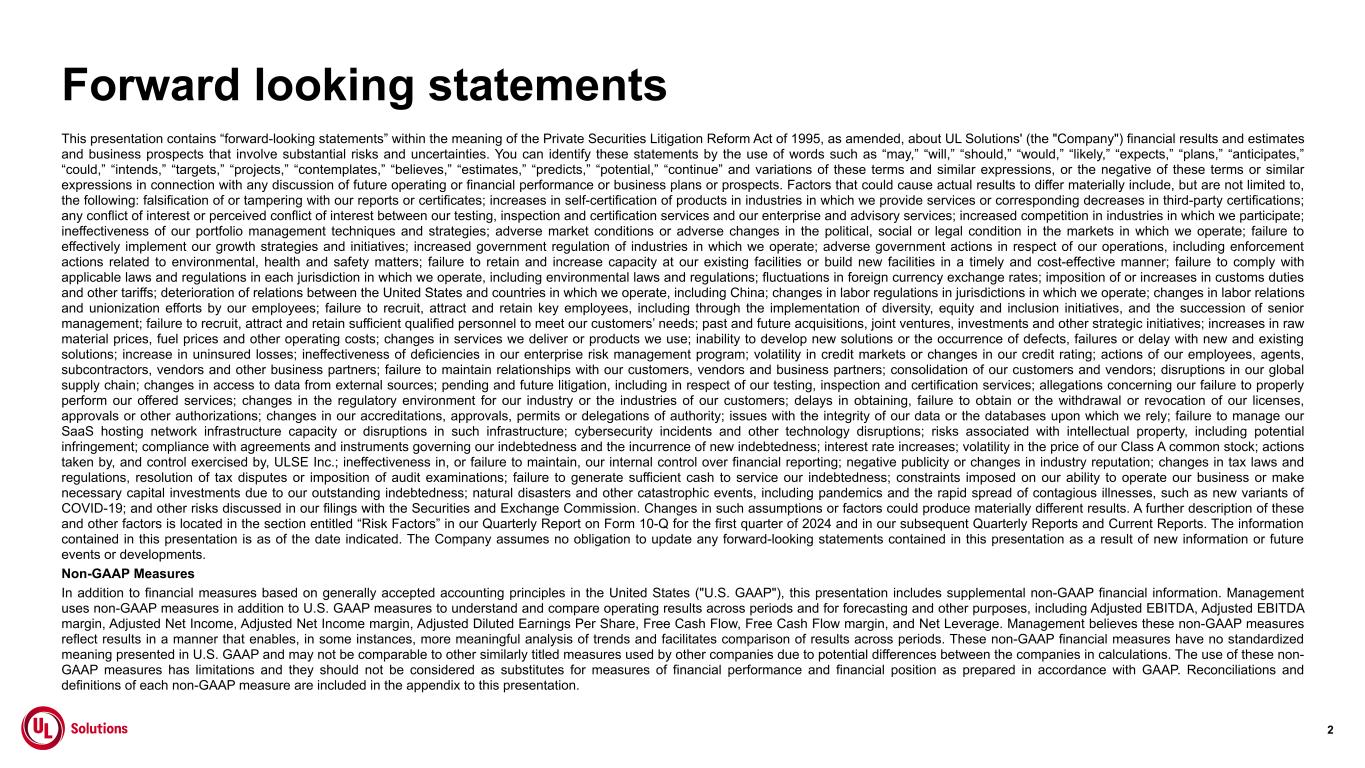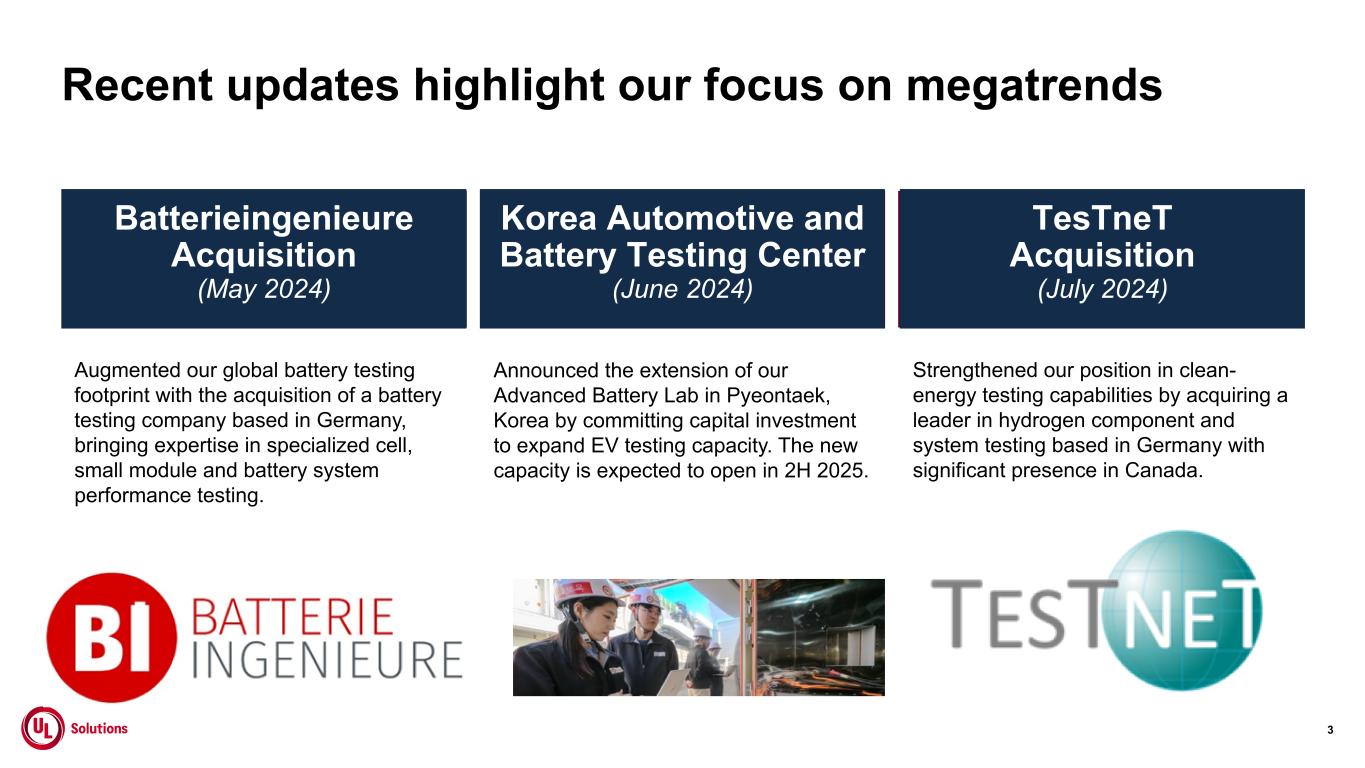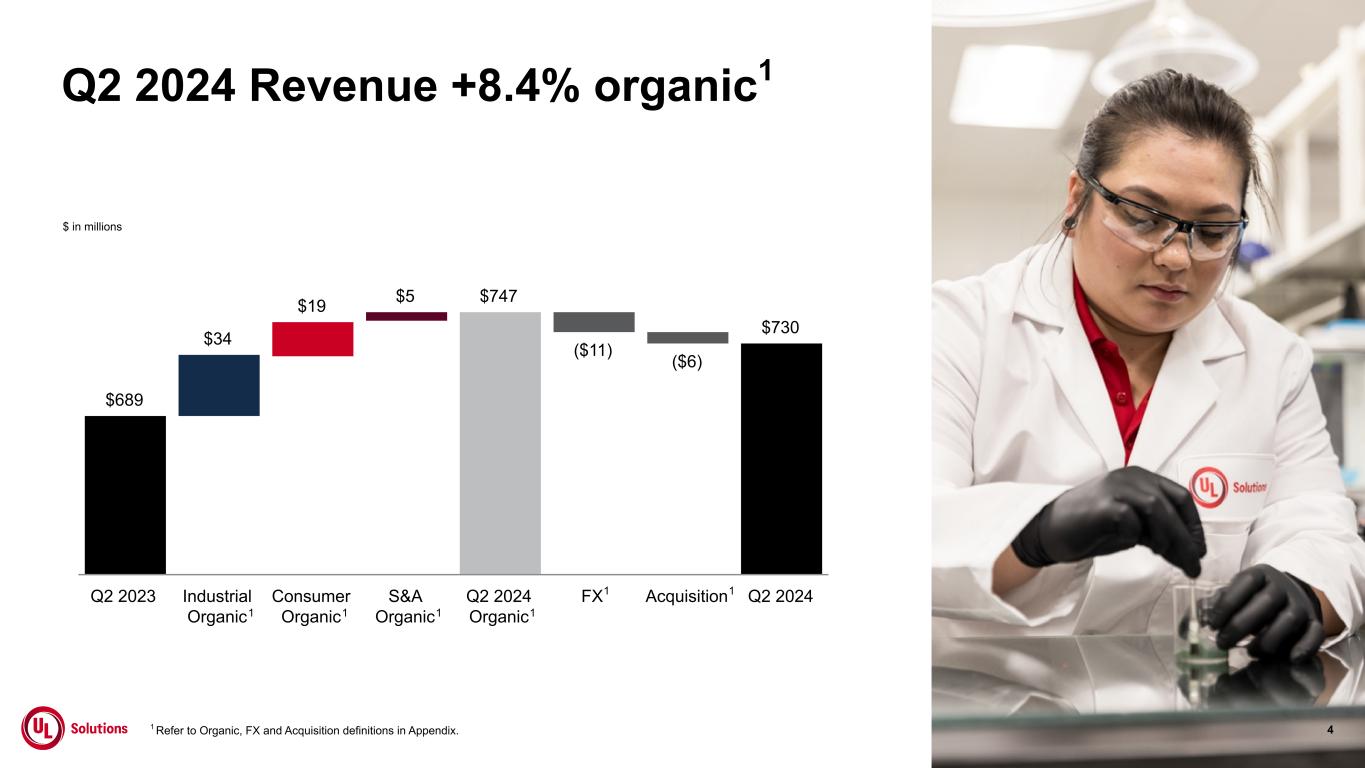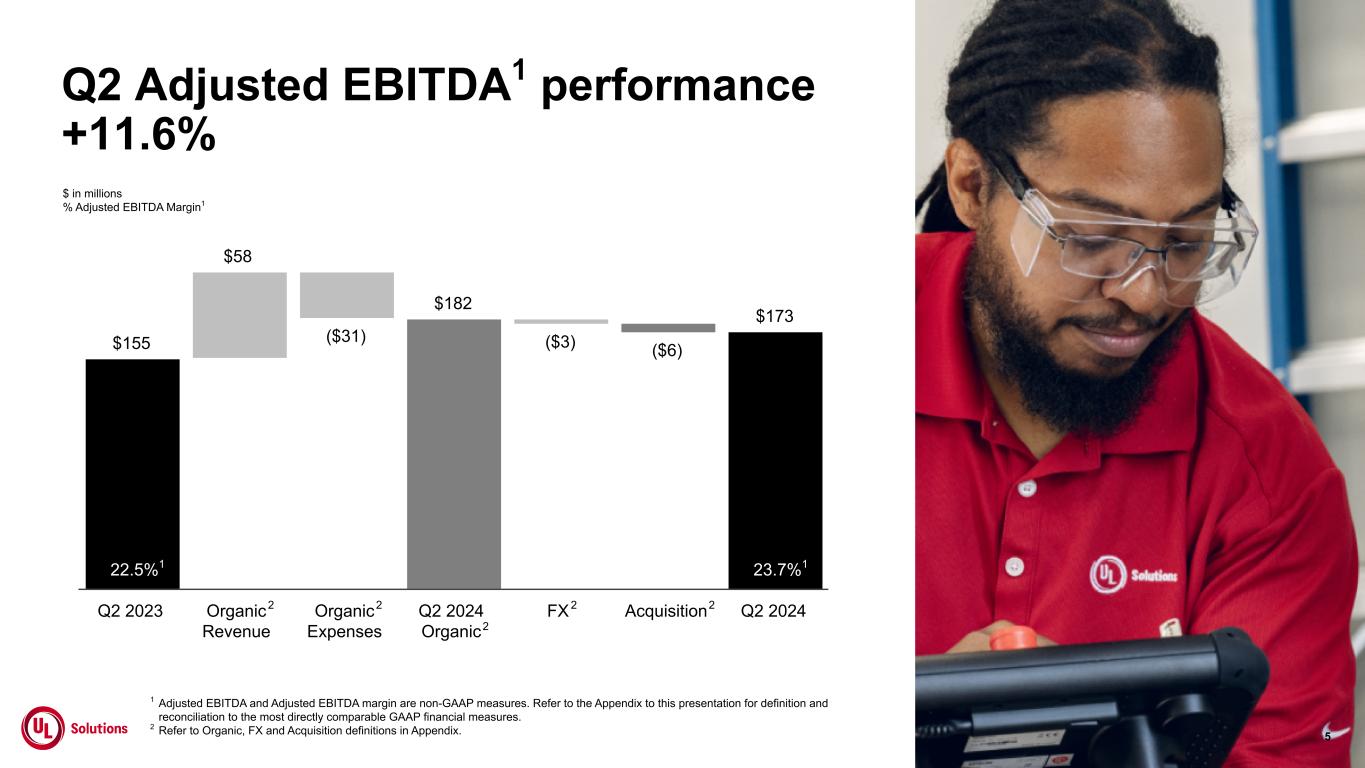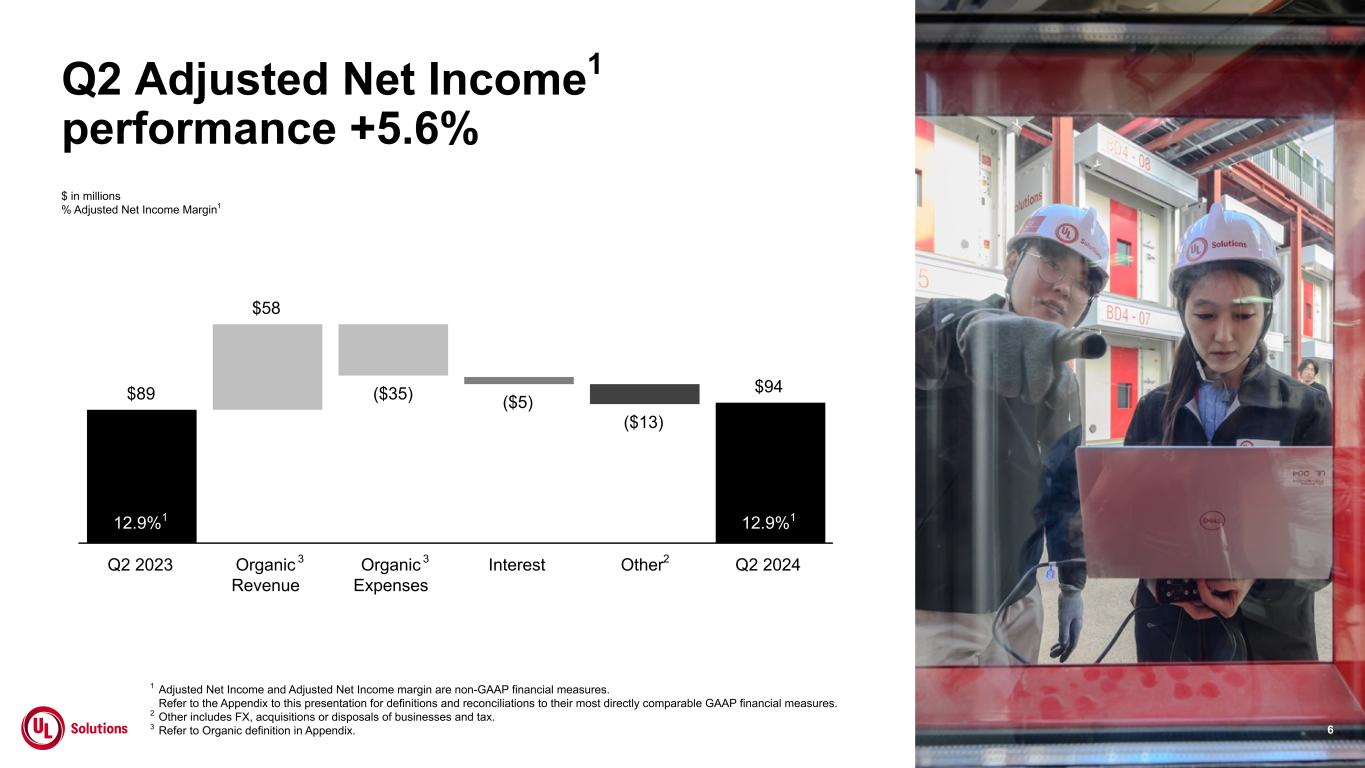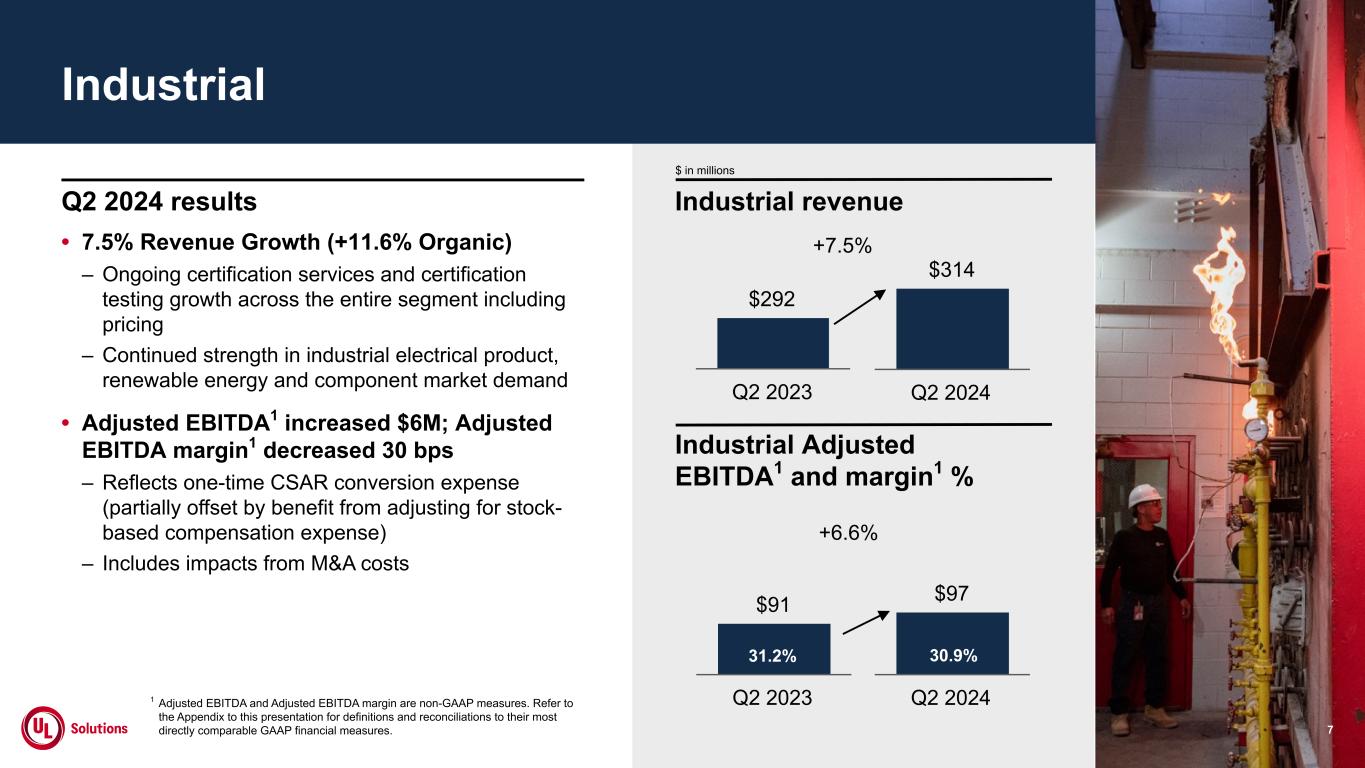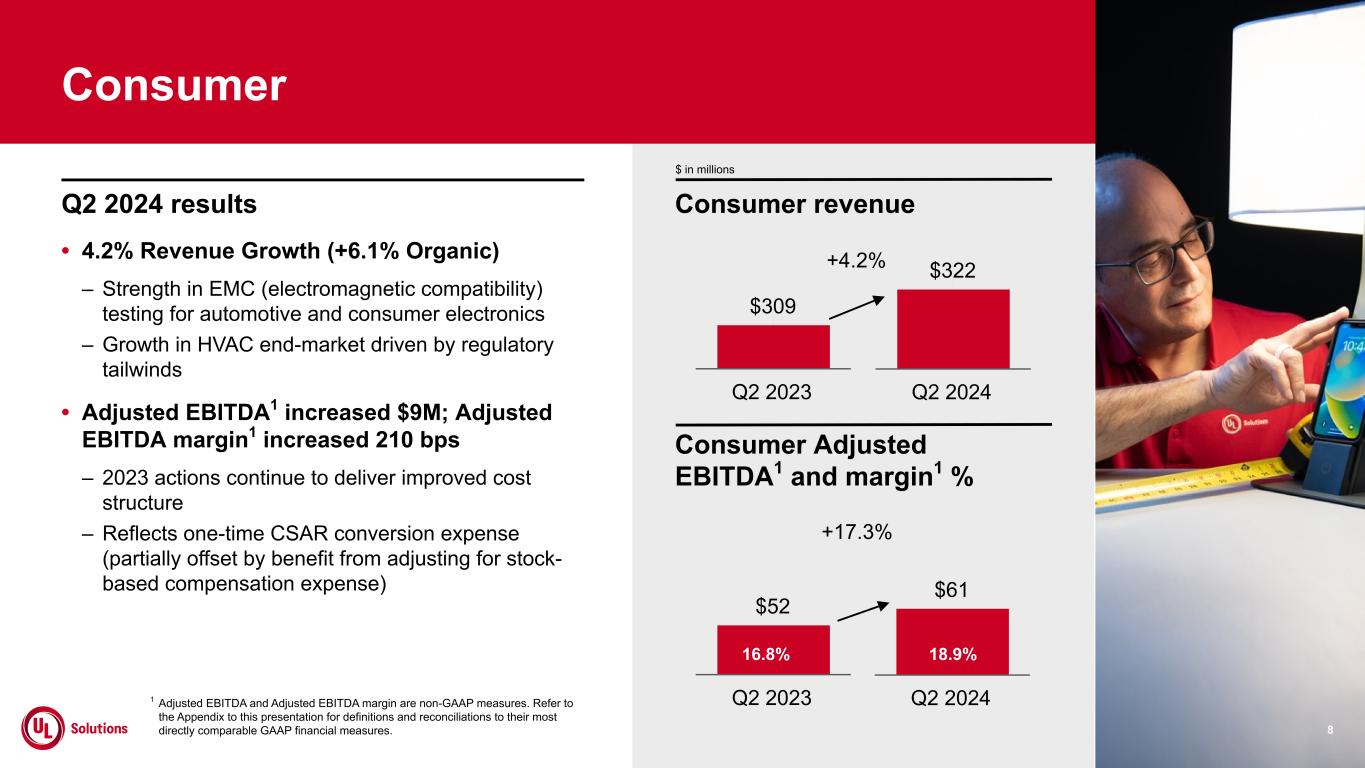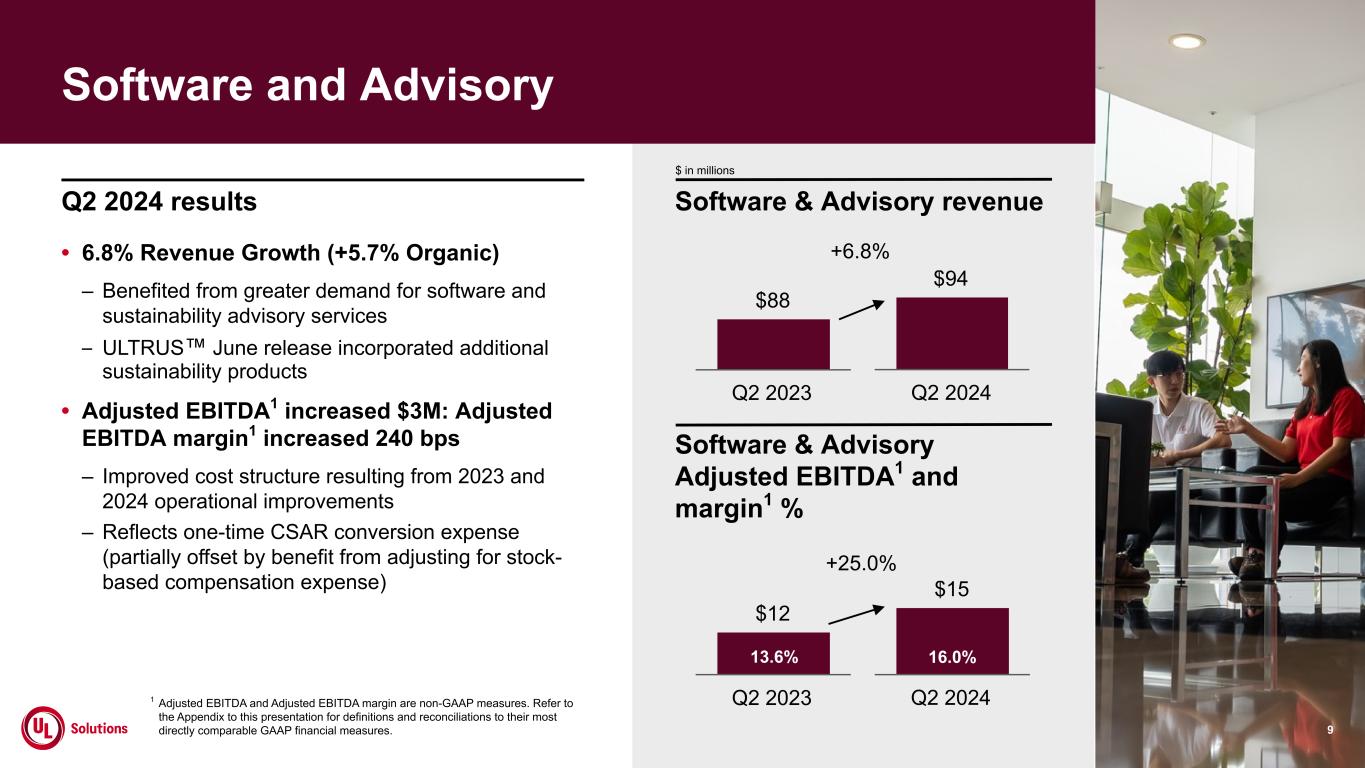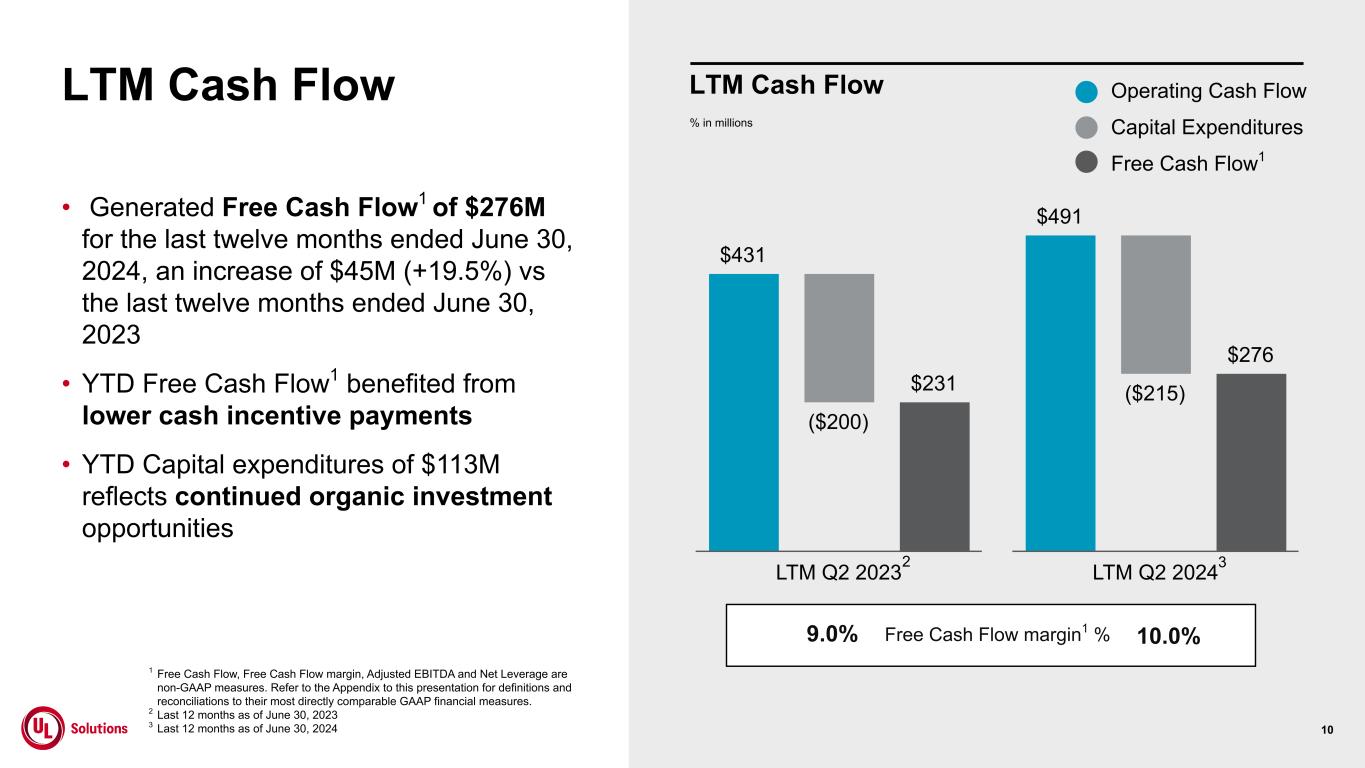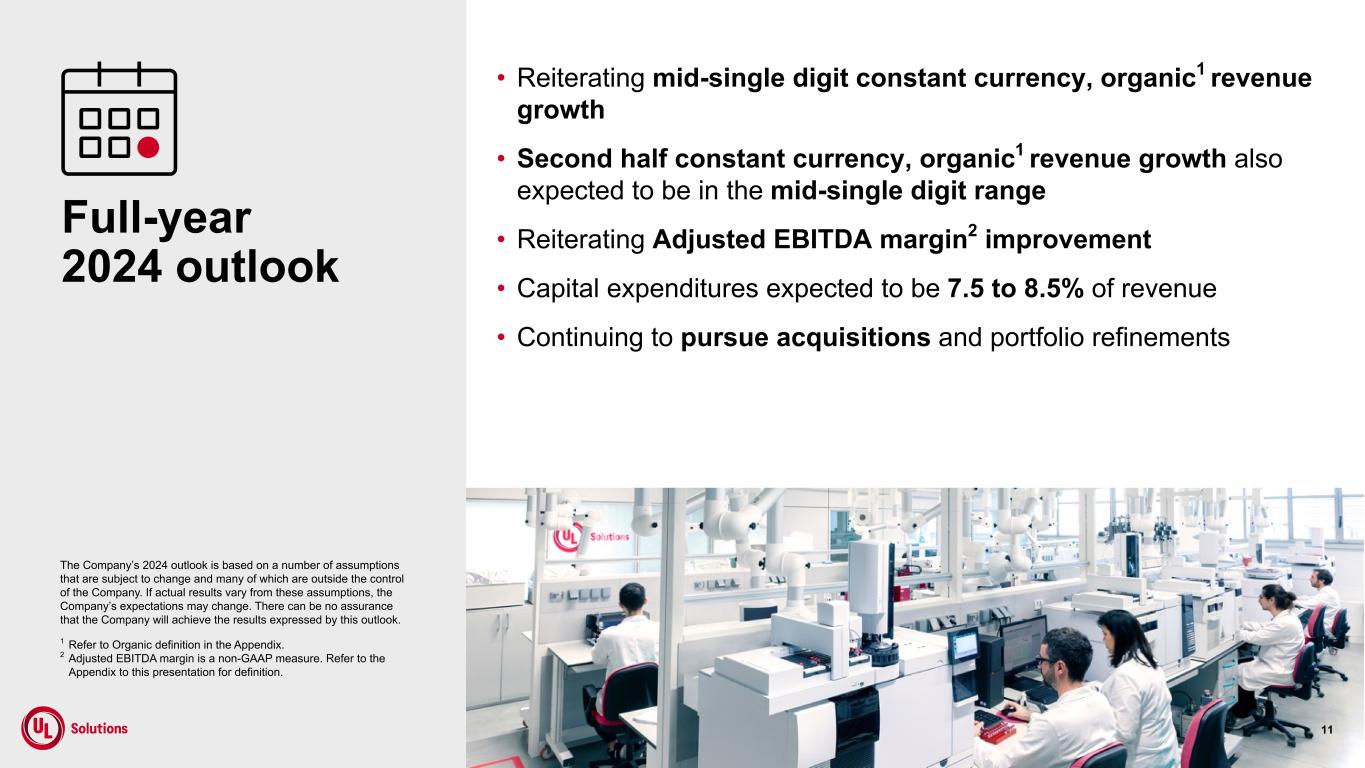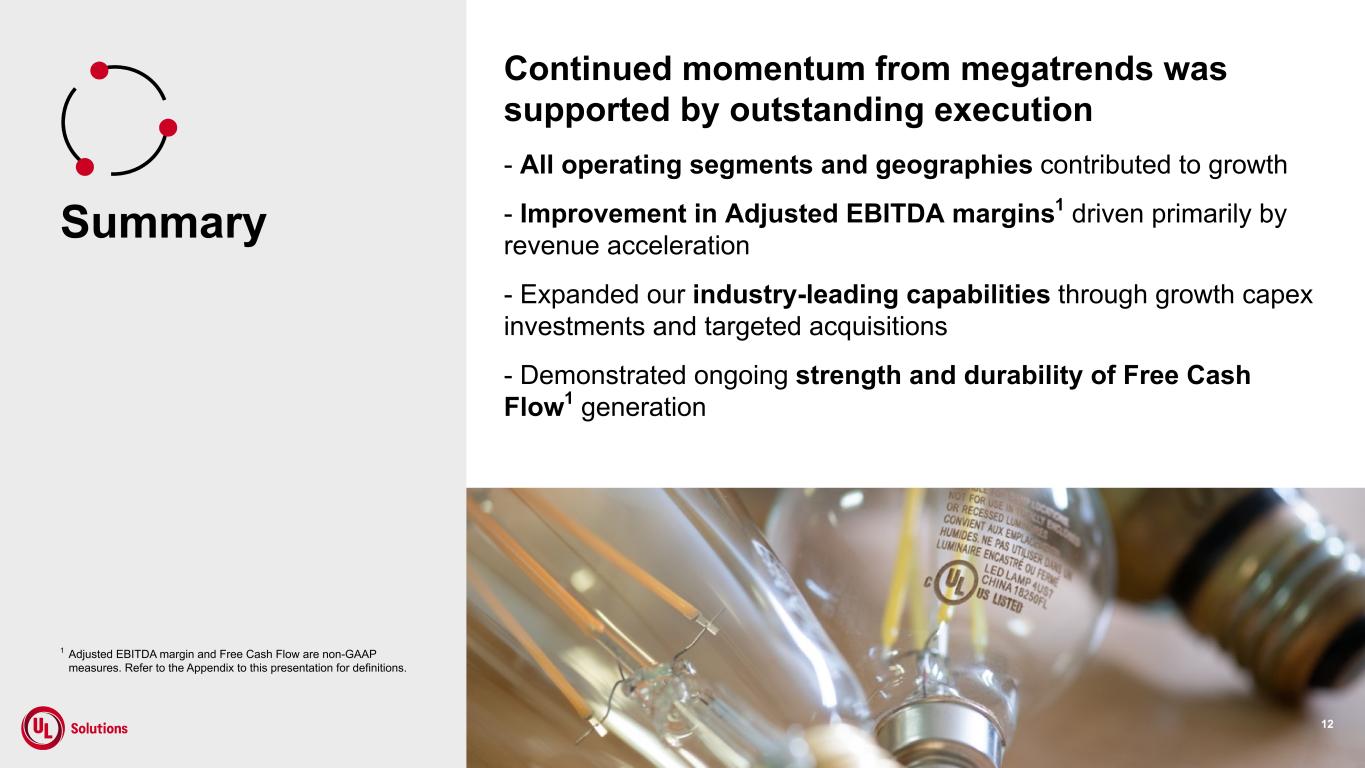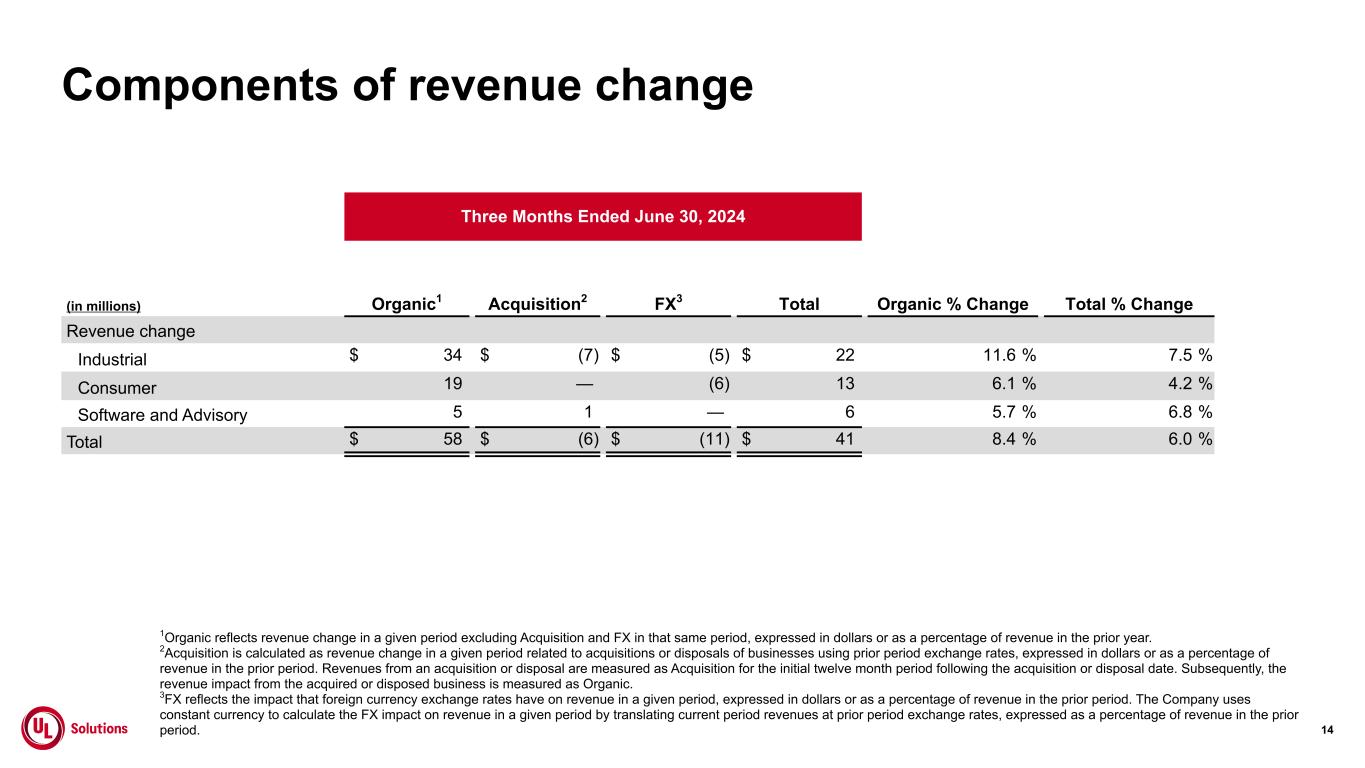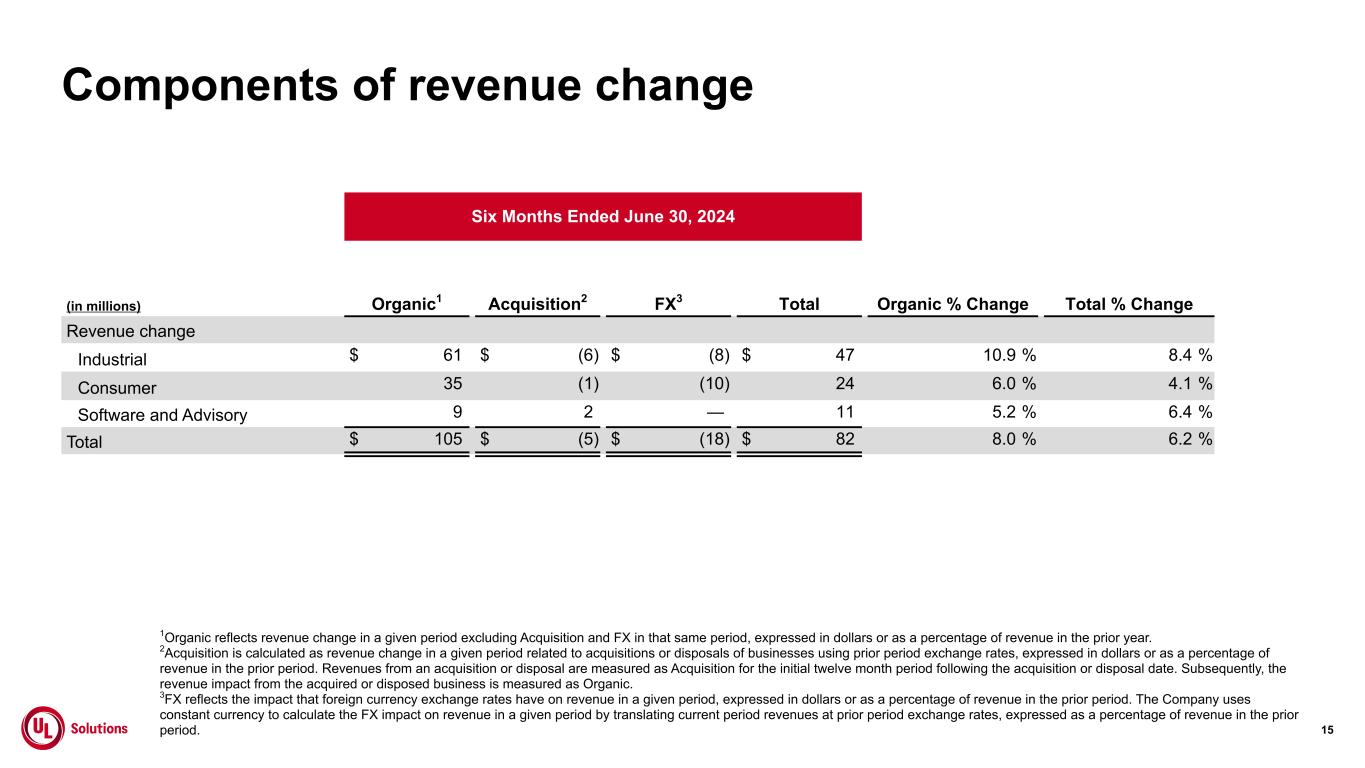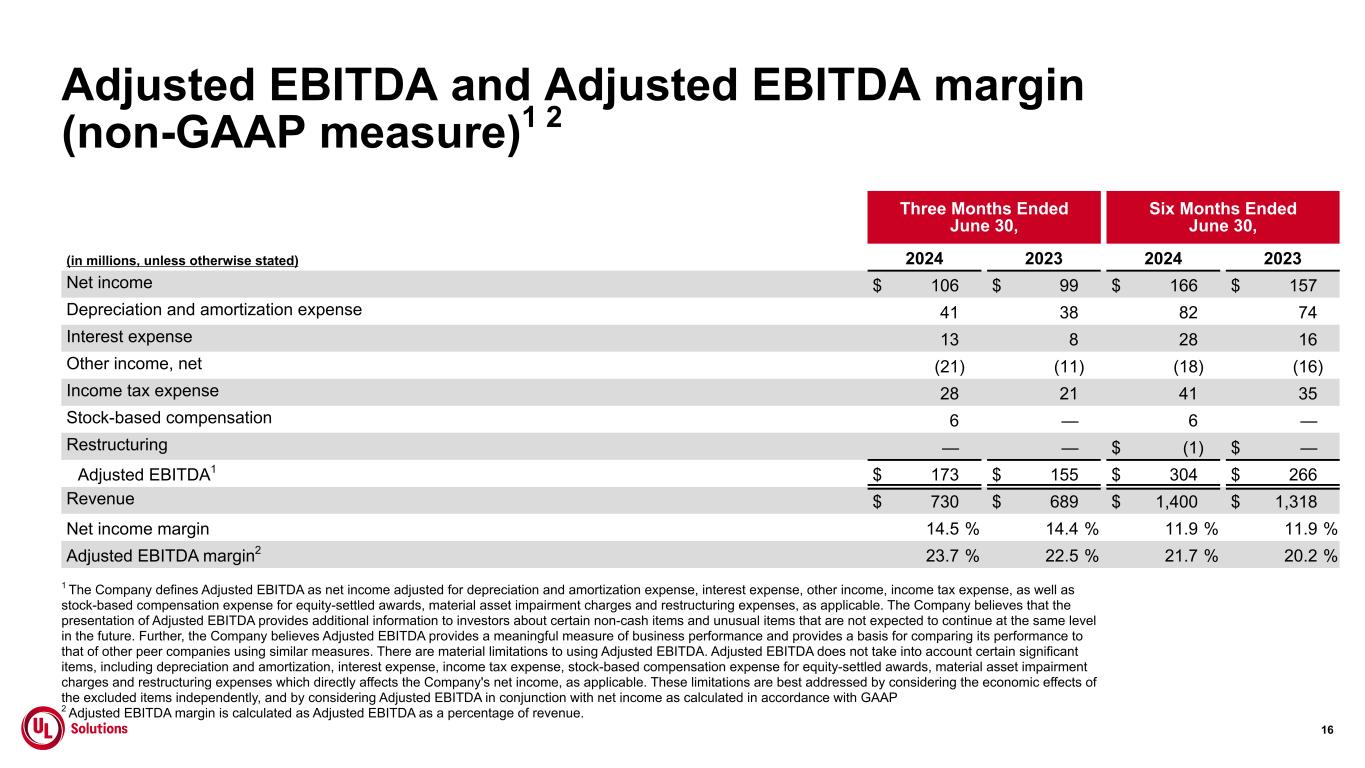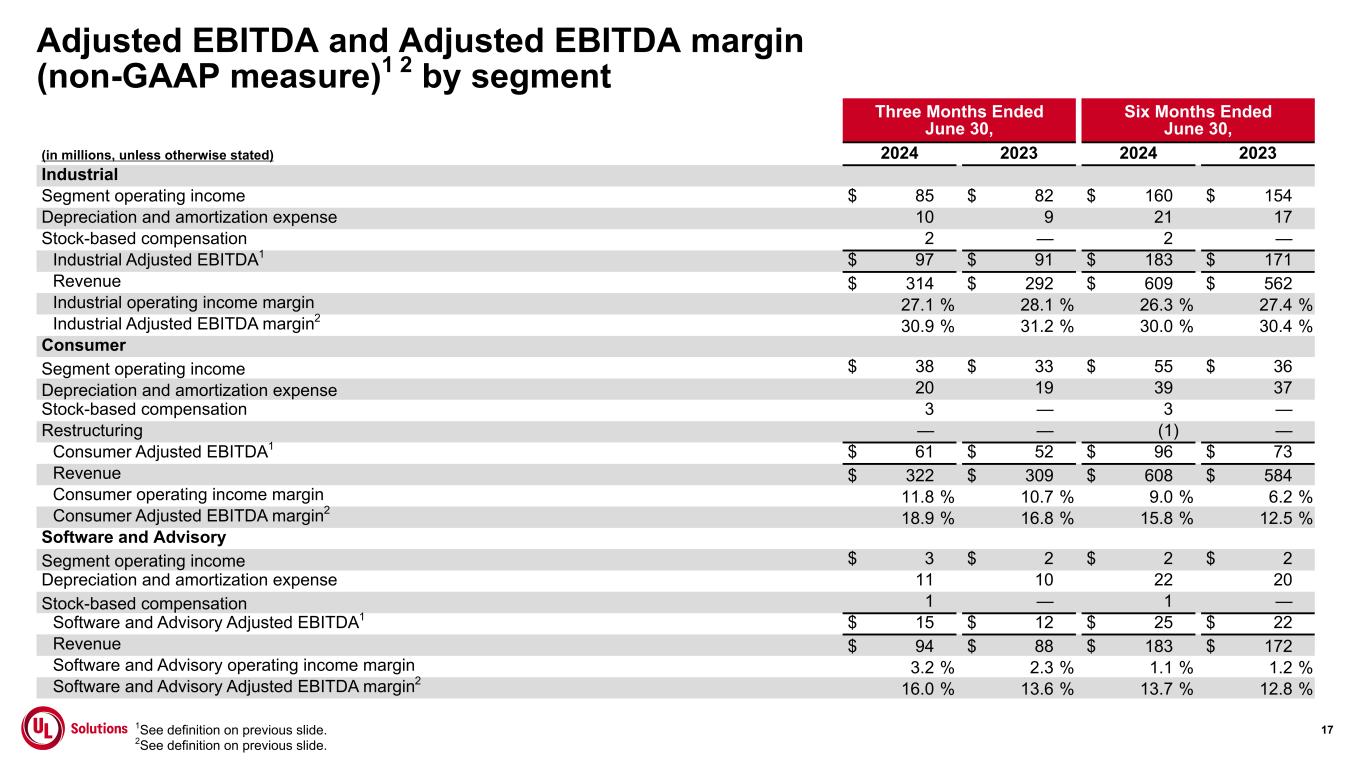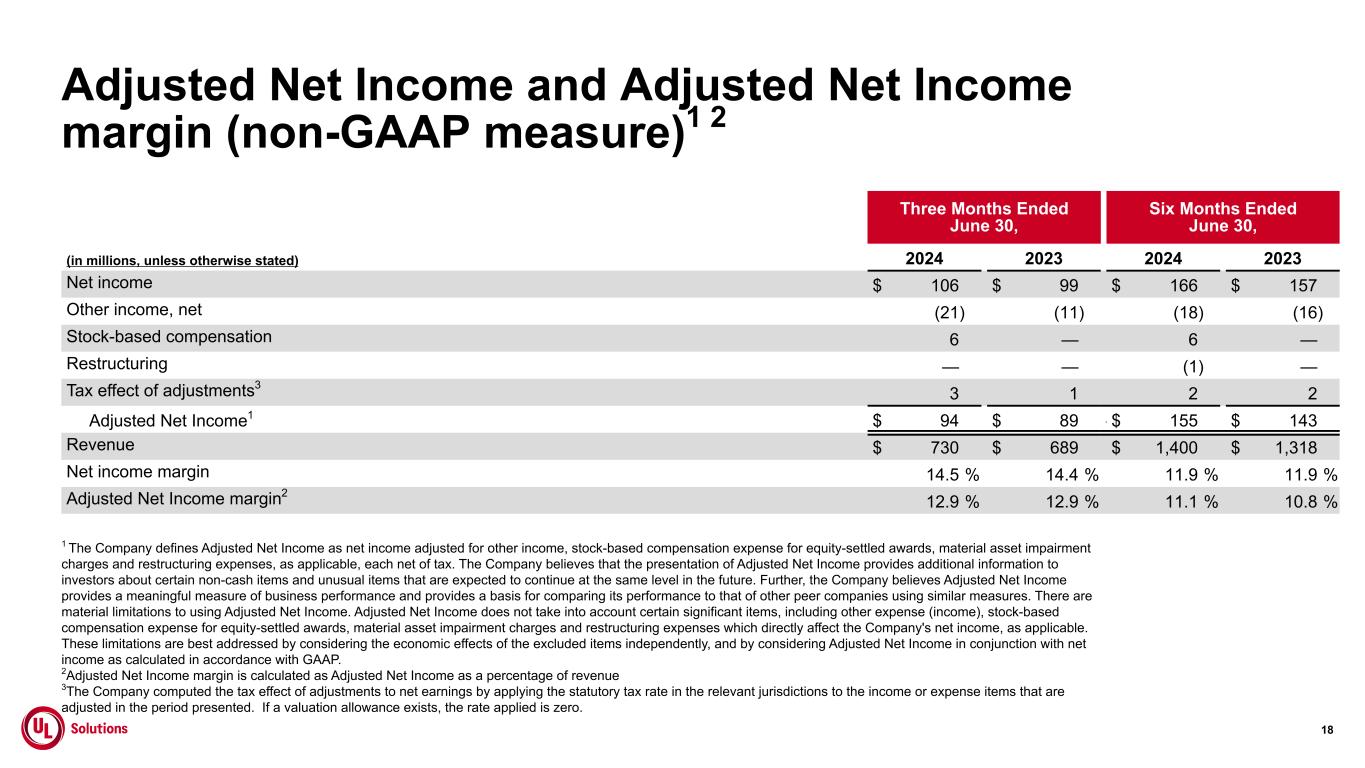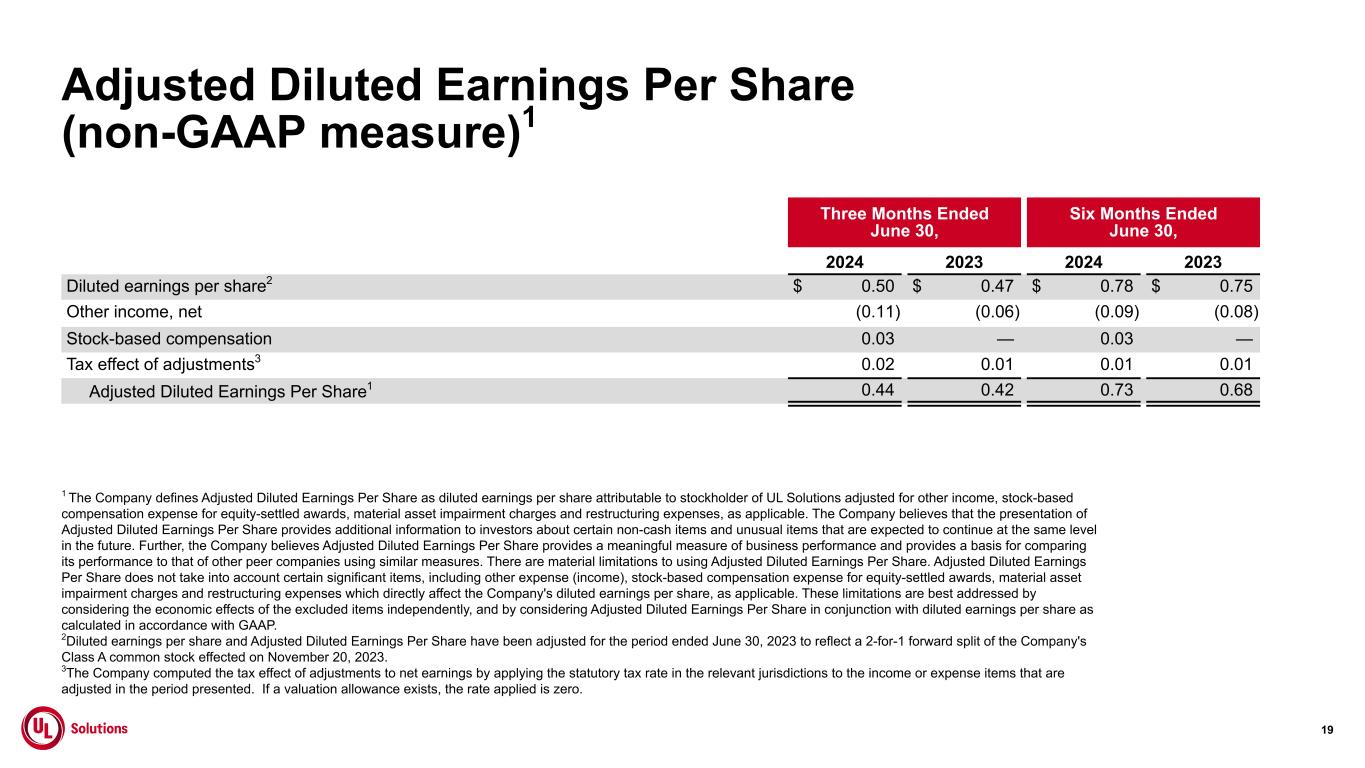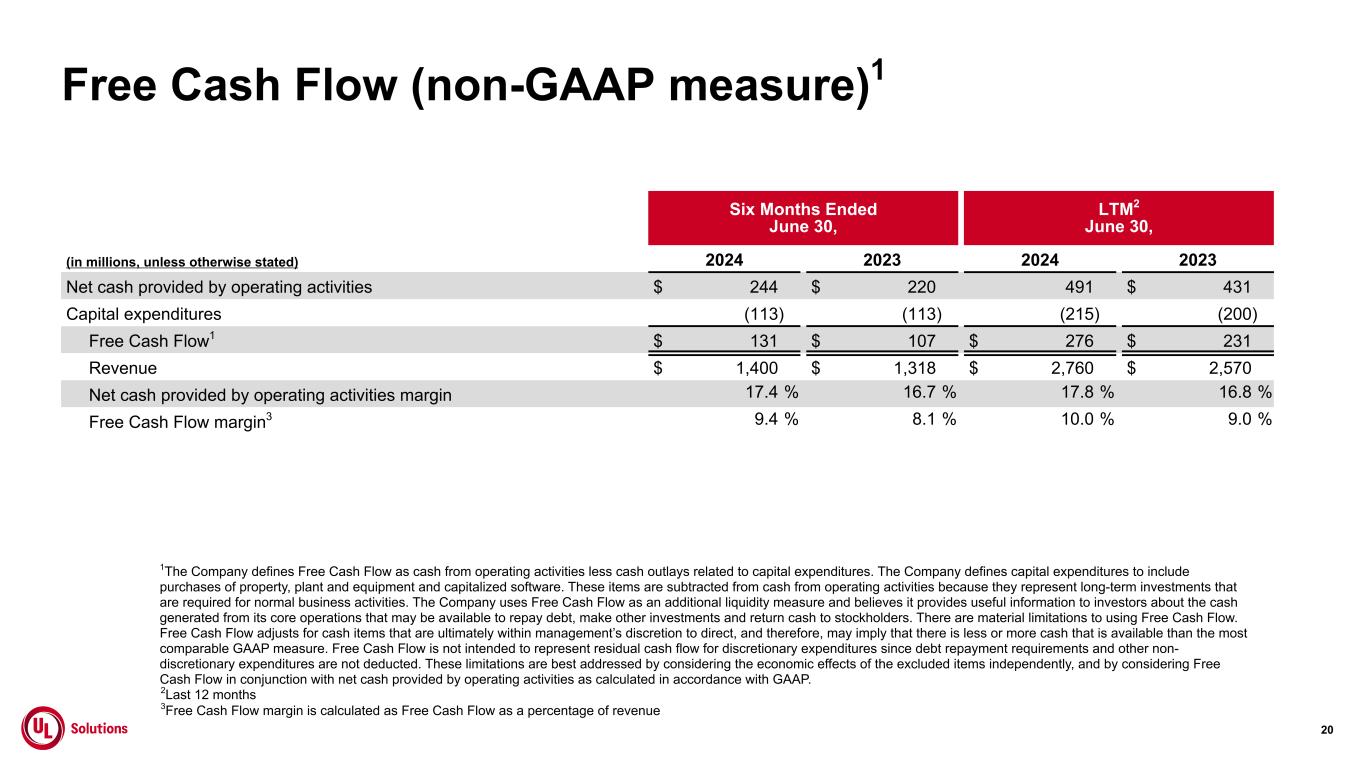Document
UL Solutions Inc. Reports Strong Second Quarter 2024 Results
Second Quarter 2024 (Comparisons to Second Quarter 2023 unless otherwise noted)1
•Strong revenue growth of 6.0% to $730 million, including 8.4% organic growth
•Net income of $106 million or, $0.50 per diluted share
•Adjusted Net Income of $94 million increased 5.6%
•Adjusted EBITDA of $173 million increased 11.6%, Adjusted EBITDA margin of 23.7% expanded 120 basis points
•Net cash provided by operating activities of $244 million and Free Cash Flow of $131 million for the first six months of 2024
•Completed upsized initial public offering at the higher end of the price range and listed on April 12th, 2024
NORTHBROOK, ILLINOIS, USA – (BUSINESS WIRE) – July 31, 2024 − UL Solutions Inc. (NYSE: ULS), a global safety science leader in independent third-party testing, inspection and certification services and related software and advisory offerings, today reported results for the second quarter ended June 30, 2024.
“This is our second quarterly earnings report as a public company and I’m pleased to once again report strong results as all of our segments, regions and service lines performed well,” said President and CEO Jennifer Scanlon. “Our revenue grew 8.4% on an organic basis and our business generated substantial cash flow. Combined with our robust balance sheet, this momentum enables ongoing investment and capital allocation aligned with megatrends impacting the world including global energy transition and sustainability.”
Scanlon continued, “We are a global leader in the Testing, Inspection and Certification business, tracing our origins back 130 years around the advent of electricity. Today we operate in over 35 industries, we continue to expand our industry-leading capabilities both organically, thanks to outstanding execution from our dedicated safety science professionals, and through targeted acquisitions.”
Chief Financial Officer Ryan Robinson added, “Tailwinds from a number of global trends are contributing to strong demand for our services and helped deliver another quarter of strong results that included organic revenue growth of 8.4%, Adjusted EBITDA of $173 million and Adjusted Diluted Earnings Per Share of $0.44. Our strong growth trajectory in the first half of 2024 puts us firmly on path to deliver on our reiterated full-year outlook. We will continue to consider prudent, accretive M&A while investing in organic growth as we look to build long-term value for all of our stakeholders.”
Second Quarter 2024 Financial Results
Revenue of $730 million compared to $689 million in the second quarter of 2023, an increase of 6.0%. Organic growth of 8.4% across all segments, led by Industrial.
Net income of $106 million compared to $99 million in the second quarter of 2023, an increase of 7.1%. Net income margin of 14.5% compared to 14.4% in the second quarter of 2023, an increase of 10 basis points.
Adjusted Net Income of $94 million compared to $89 million in the second quarter of 2023, an increase of 5.6%. Adjusted Net Income margin of 12.9% compared to 12.9% in the second quarter of 2023, as revenue gains were offset by higher compensation costs and interest expense.
Adjusted EBITDA of $173 million compared to $155 million in the second quarter of 2023, an increase of 11.6%. Adjusted EBITDA margin of 23.7% compared to 22.5% in the second quarter of 2023, an increase of 120 basis points. The margin expansion resulted from higher revenue and expense management, led by the Consumer segment.
Second Quarter 2024 Segment Performance
Industrial Segment Results
Industrial revenue of $314 million compared to $292 million in the second quarter of 2023, an increase of 7.5%, or 11.6% on an organic basis. Operating income of $85 million compared to $82 million in the second quarter of 2023. Operating income margin of 27.1% compared to 28.1% in the second quarter of 2023. Adjusted EBITDA of $97 million compared to $91 million in the second quarter of 2023, an increase of 6.6%. Adjusted EBITDA margin of 30.9% compared to 31.2% in the
1This press release includes references to non-GAAP financial measures. Please refer to “Non-GAAP Financial Measures” later in this release for the definitions of each non-GAAP financial measures presented, as well as reconciliations of these measures to their most directly comparable GAAP measures.
second quarter of 2023. Revenue and Adjusted EBITDA gains were driven by value pricing initiatives, continued demand related to electrical products, renewable energy and component certification testing, as well as increased laboratory capacity. The change in margin was primarily driven by an increase in compensation expenses related to the Company’s pre-IPO long-term incentive plans, as well as the sale of the payments testing business and due diligence related costs.
Consumer Segment Results
Consumer revenue of $322 million compared to $309 million in the second quarter of 2023, an increase of 4.2%, or 6.1% on an organic basis. Operating income of $38 million compared to $33 million in the second quarter of 2023. Operating income margin of 11.8% compared to 10.7% in the second quarter of 2023. Adjusted EBITDA of $61 million compared to $52 million in the second quarter of 2023, an increase of 17.3%. Adjusted EBITDA margin of 18.9% compared to 16.8% in the second quarter of 2023. Revenue and Adjusted EBITDA gains were driven by electromagnetic compatibility testing and improved retail demand. Margin improvement was driven by both higher revenue and higher operational efficiency.
Software and Advisory Segment Results
Software and Advisory revenue of $94 million compared to $88 million in the second quarter of 2023, an increase of 6.8%, or 5.7% on an organic basis. Operating income of $3 million compared to $2 million in the second quarter of 2023. Operating income margin of 3.2% compared to 2.3% in the second quarter of 2023. Adjusted EBITDA of $15 million compared to $12 million in the second quarter of 2023, an increase of 25.0%. Adjusted EBITDA margin of 16.0% compared to 13.6% in the second quarter of 2023. Revenue gains were driven by increased software and sustainability advisory revenue. The change in margin was primarily driven by higher revenue.
Liquidity and Capital Resources
For the first six months of 2024, the Company generated $244 million of net cash provided by operating activities, an increase from $220 million for the same period in 2023. Net cash provided by operating activities in the second quarter was impacted by lower payments related to the Company’s cash-settled stock appreciation rights.
The Company continues to make strategic capital investments in energy transition opportunities to meet increased demand, and capital expenditures were $113 million in both six months periods. Free Cash Flow for the first six months was $131 million, compared to $107 million through the second quarter of 2023.
The Company paid its first dividend as a public company of $25 million during the three months ended June 30, 2024.
As of June 30, 2024, total debt was $815 million, prior to unamortized debt issuance costs, a decrease from December 31, 2023 due to $95 million of net repayments on the Company's revolving credit facility.
The Company ended the quarter with cash and cash-equivalents of $295 million compared to $315 million at December 31, 2023.
In April 2024, the Company completed its upsized initial public offering of Class A common stock consisting entirely of secondary shares sold by the selling stockholder. UL Solutions did not sell any shares in the offering and did not receive any proceeds from the sale of the shares.
Full-Year 2024 Outlook
Our key points on 2024 outlook include:
•Reiterating mid-single digit constant currency, organic revenue growth
•Second half constant currency, organic revenue growth also expected to be in the mid-single digit range
•Reiterating Adjusted EBITDA margin improvement
•Capital expenditures expected to be 7.5 to 8.5% of revenue
•Continuing to pursue acquisitions and portfolio refinements
The Company’s 2024 outlook is based on a number of assumptions that are subject to change and many of which are outside the control of the Company. If actual results vary from these assumptions, the Company’s expectations may change. There can be no assurance that the Company will achieve the results expressed by this outlook.
Conference Call and Webcast
UL Solutions will host a conference call today at 8:30 am ET to discuss the Company’s financial results. The live webcast of the conference call and accompanying presentation materials can be accessed through the UL Solutions Investor Relations website at ir.ul.com. For those unable to access the webcast, the conference call can be accessed by dialing 877-269-7751 or 201-389-0908. An archive of the webcast will be available on the Company’s website for 30 days.
About UL Solutions
A global leader in applied safety science, UL Solutions Inc. transforms safety, security and sustainability challenges into opportunities for customers in more than 100 countries. UL Solutions Inc. delivers testing, inspection and certification services, together with software products and advisory offerings, that support our customers’ product innovation and business growth. The UL Mark serves as a recognized symbol of trust in our customers’ products and reflects an unwavering commitment to advancing our safety mission. We help our customers innovate, launch new products and services, navigate global markets and complex supply chains, and grow sustainably and responsibly into the future. Our science is your advantage.
Investors and others should note that UL Solutions intends to routinely announce material information to investors and the marketplace using SEC filings, press releases, public conference calls, webcasts and the UL Solutions Investor Relations website. We also intend to use certain social media channels as a means of disclosing information about us and our products to consumers, our customers, investors and the public on our X account (@UL_Solutions) and our LinkedIn account (@ULSolutions). The information posted on social media channels is not incorporated by reference in this press release or in any other report or document we file with the SEC. While not all of the information that the Company posts to the UL Solutions Investor Relations website or to social media accounts is of a material nature, some information could be deemed to be material. Accordingly, the Company encourages investors, the media, and others interested in UL Solutions to review the information shared on our Investor Relations website at ir.ul.com and to regularly follow our social media accounts. Users can automatically receive email alerts and information about the Company by subscribing to “Investor Email Alerts” at the bottom of the UL Solutions Investor Relations website at ir.ul.com.
Forward-Looking Statements
Certain statements in this press release, which are not historical facts, are forward-looking statements within the meaning of the Private Securities Litigation Reform Act of 1995. These include statements regarding management’s objectives and the Company’s plans, strategy, outlook and future financial performance. In some cases, you can identify forward-looking statements by the use of words such as “may,” “could,” “seek,” “guidance,” “predict,” “potential,” “likely,” “believe,” “will,” “expect,” “anticipate,” “estimate,” “plan,” “intend,” “forecast,” “aim,” “objectives,” “target,” “outlook,” “guidance” and variations, or the negative, of these terms and similar expressions. Such forward-looking statements are necessarily based upon estimates and assumptions that, while management considers reasonable, are inherently uncertain.
There are many risks, uncertainties and other factors that could cause actual results to differ materially from those expressed or implied by the forward-looking statements made in this press release, including, but not limited to, the following: falsification of or tampering with our reports or certificates; increases in self-certification of products in industries in which we provide services or corresponding decreases in third-party certifications; any conflict of interest or perceived conflict of interest between our testing, inspection and certification services and our enterprise and advisory services; increased competition in industries in which we participate; ineffectiveness of our portfolio management techniques and strategies; adverse market conditions or adverse changes in the political, social or legal condition in the markets in which we operate; failure to effectively implement our growth strategies and initiatives; increased government regulation of industries in which we operate; adverse government actions in respect of our operations, including enforcement actions related to environmental, health and safety matters; failure to retain and increase capacity at our existing facilities or build new facilities in a timely and cost-effective manner; failure to comply with applicable laws and regulations in each jurisdiction in which we operate, including environmental laws and regulations; fluctuations in foreign currency exchange rates; imposition of or increases in customs duties and other tariffs; deterioration of relations between the United States and countries in which we operate, including China; changes in labor regulations in jurisdictions in which we operate; changes in labor relations and unionization efforts by our employees; failure to recruit, attract and retain key employees, including through the implementation of diversity, equity and inclusion initiatives, and the succession of senior management; failure to recruit, attract and retain sufficient qualified personnel to meet our customers’ needs; past and future acquisitions, joint ventures, investments and other strategic initiatives; increases in raw material prices, fuel prices and other operating costs; changes in services we deliver or products we use; inability to develop new solutions or the occurrence of defects, failures or delay with new and existing solutions; increase in uninsured losses; ineffectiveness of deficiencies in our enterprise risk management program; volatility in credit markets or changes in our credit rating; actions of our employees, agents, subcontractors, vendors and other business partners; failure to maintain relationships with our customers, vendors and business partners; consolidation of our customers and vendors; disruptions in our global supply chain; changes in access to data from external sources; pending and future litigation, including in respect of our testing, inspection and certification services; allegations concerning our failure to properly perform our offered services; changes in the regulatory environment for our industry or the industries of our customers; delays in obtaining, failure to obtain or the withdrawal or revocation of our licenses, approvals or other authorizations; changes in our accreditations, approvals, permits or delegations of authority; issues with the integrity of our data or the databases upon which we rely; failure to manage our SaaS hosting network infrastructure capacity or disruptions in such infrastructure; cybersecurity incidents and other technology disruptions; risks associated with intellectual property, including potential infringement; compliance with agreements and instruments governing our indebtedness and the incurrence of new indebtedness; interest rate increases; volatility in the price of our Class A common stock; actions taken by, and control exercised by, ULSE Inc., our parent and controlling stockholder; ineffectiveness in, or failure to maintain, our internal control over financial reporting; negative publicity or changes in industry reputation; changes in tax laws and regulations, resolution of tax disputes or imposition of audit examinations; failure to generate sufficient cash to service our indebtedness; constraints imposed on our ability to operate our business or make necessary capital investments due to our outstanding indebtedness; natural disasters and other catastrophic events, including pandemics and the rapid spread of contagious illnesses; and other risks discussed in our filings with the Securities and Exchange Commission (the “SEC”), including our Registration Statement on Form S-1, as amended (File No. 333-275468) and our Quarterly Report on Form 10-Q for the quarter ended March 31, 2024, as well as other factors described from time to time in our filings with the SEC.
All forward-looking statements attributable to us or persons acting on our behalf are expressly qualified in their entirety by the cautionary statements set forth above. We caution you not to place undue reliance on any forward-looking statements, which are made only as of the date of this press release. We do not undertake or assume any obligation to update publicly any of these forward-looking statements to reflect actual results, new information or future events, changes in assumptions or changes in other factors affecting such forward-looking statements, except to the extent required by law. If we update one or more forward-looking statements, no inference should be drawn that we will make additional updates with respect to those or other forward-looking statements.
Non-GAAP Measures
In addition to financial measures based on accounting principles generally accepted in the United States of America (“GAAP”), this presentation includes supplemental non-GAAP financial information, including the presentation of Adjusted EBITDA, Adjusted EBITDA margin, Adjusted Net Income, Adjusted Net Income margin, Adjusted Diluted Earnings Per Share and Free Cash Flow. Management uses non-GAAP measures in addition to GAAP measures to understand and compare operating results across periods and for forecasting and other purposes. Management believes these non-GAAP measures reflect results in a manner that enables, in some instances, more meaningful analysis of trends and facilitates comparison of results across periods. These non-GAAP financial measures have no standardized meaning presented in U.S. GAAP and may not be comparable to other similarly titled measures used by other companies due to potential differences between the companies in calculations. The use of these non-GAAP measures has limitations, and they should not be considered as substitutes for measures of financial performance and financial position as prepared in accordance with GAAP. See “Non-GAAP Financial Measures” below for definitions of these non-GAAP measures, and reconciliations to their most directly comparable GAAP measures.
Media:
Kathy Fieweger
Senior Vice President - Communications
Kathy.Fieweger@ul.com
+1 312-852-5156
Investors:
Dan Scott / Rodny Nacier, ICR Inc.
IR@ul.com
|
|
|
| UL Solutions Inc. |
| Condensed Consolidated Statements of Operations |
| (Unaudited) |
|
|
|
|
|
|
|
|
|
|
|
|
|
|
|
|
|
|
|
|
|
|
|
|
|
Three Months Ended
June 30, |
|
Six Months Ended
June 30, |
| (in millions, except per share data) |
2024 |
|
2023 |
|
2024 |
|
2023 |
| Revenue |
$ |
730 |
|
|
$ |
689 |
|
|
$ |
1,400 |
|
|
$ |
1,318 |
|
| Cost of revenue |
364 |
|
|
352 |
|
|
715 |
|
|
687 |
|
| Selling, general and administrative expenses |
240 |
|
|
220 |
|
|
468 |
|
|
439 |
|
|
|
|
|
|
|
|
|
| Operating income |
126 |
|
|
117 |
|
|
217 |
|
|
192 |
|
| Interest expense |
(13) |
|
|
(8) |
|
|
(28) |
|
|
(16) |
|
| Other income, net |
21 |
|
|
11 |
|
|
18 |
|
|
16 |
|
| Income before income taxes |
134 |
|
|
120 |
|
|
207 |
|
|
192 |
|
| Income tax expense |
28 |
|
|
21 |
|
|
41 |
|
|
35 |
|
| Net income |
106 |
|
|
99 |
|
|
166 |
|
|
157 |
|
| Less: net income attributable to non-controlling interests |
5 |
|
|
5 |
|
|
9 |
|
|
8 |
|
| Net income attributable to stockholders of UL Solutions |
$ |
101 |
|
|
$ |
94 |
|
|
$ |
157 |
|
|
$ |
149 |
|
|
|
|
|
|
|
|
|
| Earnings per common share: |
|
|
|
|
|
|
|
| Basic |
$ |
0.51 |
|
|
$ |
0.47 |
|
|
$ |
0.79 |
|
|
$ |
0.75 |
|
| Diluted |
$ |
0.50 |
|
|
$ |
0.47 |
|
|
$ |
0.78 |
|
|
$ |
0.75 |
|
|
|
|
|
|
|
|
|
| Weighted average common shares outstanding: |
|
|
|
|
|
|
|
| Basic |
200 |
|
|
200 |
|
|
200 |
|
|
200 |
|
|
|
|
|
|
|
|
|
|
|
|
|
|
|
|
|
| Diluted |
201 |
|
|
200 |
|
|
201 |
|
|
200 |
|
|
|
|
| UL Solutions Inc. |
| Condensed Consolidated Balance Sheets |
| (Unaudited) |
|
|
|
|
|
|
|
|
|
|
|
|
| (in millions, except per share data) |
June 30, 2024 |
|
December 31, 2023 |
| Assets |
|
|
|
| Current assets: |
|
|
|
| Cash and cash equivalents |
$ |
295 |
|
|
$ |
315 |
|
|
|
|
|
| Accounts receivable, net |
381 |
|
|
362 |
|
| Contract assets, net |
206 |
|
|
179 |
|
| Other current assets |
75 |
|
|
97 |
|
|
|
|
|
| Total current assets |
957 |
|
|
953 |
|
|
|
|
|
| Property, plant and equipment, net |
554 |
|
|
555 |
|
| Goodwill |
628 |
|
|
623 |
|
| Intangible assets, net |
63 |
|
|
72 |
|
| Operating lease right-of-use assets |
145 |
|
|
151 |
|
| Deferred income taxes |
118 |
|
|
110 |
|
| Capitalized software, net |
135 |
|
|
139 |
|
| Other assets |
142 |
|
|
133 |
|
| Total Assets |
$ |
2,742 |
|
|
$ |
2,736 |
|
| Liabilities and Stockholders’ Equity |
|
|
|
| Current liabilities: |
|
|
|
| Accounts payable |
$ |
134 |
|
|
$ |
169 |
|
| Accrued compensation and benefits |
171 |
|
|
281 |
|
| Operating lease liabilities - current |
36 |
|
|
39 |
|
| Contract liabilities |
317 |
|
|
162 |
|
| Other current liabilities |
82 |
|
|
58 |
|
| Total current liabilities |
740 |
|
|
709 |
|
| Long-term debt |
785 |
|
|
904 |
|
| Pension and postretirement benefit plans |
223 |
|
|
232 |
|
| Operating lease liabilities |
117 |
|
|
120 |
|
|
|
|
|
| Other liabilities |
91 |
|
|
93 |
|
| Total Liabilities |
1,956 |
|
|
2,058 |
|
|
|
|
|
|
|
|
|
|
|
|
|
|
|
|
|
|
|
|
|
|
|
|
|
|
|
|
|
|
|
|
|
| Total Stockholders’ Equity |
786 |
|
|
678 |
|
| Total Liabilities and Stockholders’ Equity |
$ |
2,742 |
|
|
$ |
2,736 |
|
|
|
|
| UL Solutions Inc. |
Condensed Consolidated Statements of Cash Flows
|
| (Unaudited) |
|
|
|
|
|
|
|
|
|
|
|
|
|
Six Months Ended June 30, |
| (in millions) |
2024 |
|
2023 |
| Operating activities |
|
|
|
|
|
|
|
|
|
|
|
|
|
|
|
|
|
|
|
|
|
|
|
|
|
|
|
|
|
|
|
|
|
|
|
|
|
|
|
|
|
|
|
|
|
|
|
|
|
|
|
|
|
|
|
|
|
|
|
|
|
|
|
|
|
|
|
|
|
|
|
|
|
|
|
|
|
|
|
|
|
|
|
| Net cash flows provided by operating activities |
$ |
244 |
|
|
$ |
220 |
|
|
|
|
|
| Investing activities |
|
|
|
| Capital expenditures |
(113) |
|
|
(113) |
|
| Acquisitions, net of cash acquired |
(10) |
|
|
(1) |
|
|
|
|
|
|
|
|
|
|
|
|
|
|
|
|
|
|
|
|
|
| Proceeds from divestitures |
30 |
|
|
4 |
|
| Other investing activities, net |
— |
|
|
25 |
|
| Net cash flows used in investing activities |
(93) |
|
|
(85) |
|
|
|
|
|
| Financing activities |
|
|
|
|
|
|
|
|
|
|
|
|
|
|
|
| Repayments of long-term debt, net |
(95) |
|
|
— |
|
|
|
|
|
|
|
|
|
| Dividends to stockholders of UL Solutions |
(50) |
|
|
(40) |
|
| Dividend to non-controlling interest |
(15) |
|
|
— |
|
| Other financing activities, net |
1 |
|
|
1 |
|
| Net cash flows used in financing activities |
(159) |
|
|
(39) |
|
|
|
|
|
| Effect of exchange rate changes on cash and cash equivalents |
(12) |
|
|
(5) |
|
|
|
|
|
| Net (decrease) increase in cash and cash equivalents |
(20) |
|
|
91 |
|
|
|
|
|
| Cash and cash equivalents |
|
|
|
| Beginning of period |
315 |
|
|
322 |
|
| End of period |
$ |
295 |
|
|
$ |
413 |
|
|
|
|
|
|
|
|
|
|
|
|
|
|
|
|
|
|
|
|
|
|
|
|
|
|
|
|
|
|
|
|
|
|
|
|
| UL Solutions Inc. |
| Supplemental Financial Information |
| Revenue by Major Service Category and Revenue Growth Components |
| (Unaudited) |
|
|
|
|
|
|
|
|
|
|
|
|
|
|
|
|
|
|
|
|
|
|
|
|
| Revenue by Major Service Category |
Three Months Ended
June 30, |
|
Six Months Ended
June 30, |
| (in millions) |
2024 |
|
2023 |
|
2024 |
|
2023 |
| Certification Testing |
$ |
203 |
|
|
$ |
188 |
|
|
$ |
379 |
|
|
$ |
349 |
|
| Ongoing Certification Services |
234 |
|
|
217 |
|
|
467 |
|
|
436 |
|
| Non-certification Testing and Other Services |
225 |
|
|
216 |
|
|
419 |
|
|
398 |
|
| Software |
68 |
|
|
68 |
|
|
135 |
|
|
135 |
|
| Total |
$ |
730 |
|
|
$ |
689 |
|
|
$ |
1,400 |
|
|
$ |
1,318 |
|
|
|
|
|
|
|
|
|
|
|
|
|
|
|
|
|
|
|
|
|
|
|
|
|
|
|
|
|
|
|
|
|
|
|
|
|
| Revenue Change Components |
Three Months Ended June 30, 2024 |
|
|
|
|
| (in millions) |
Organic1 |
|
Acquisition2 |
|
FX3 |
|
Total |
|
Organic % Change |
|
Total % Change |
| Revenue change |
|
|
|
|
|
|
|
|
|
|
|
| Industrial |
$ |
34 |
|
|
$ |
(7) |
|
|
$ |
(5) |
|
|
$ |
22 |
|
|
11.6 |
% |
|
7.5 |
% |
| Consumer |
19 |
|
|
— |
|
|
(6) |
|
|
13 |
|
|
6.1 |
% |
|
4.2 |
% |
| Software and Advisory |
5 |
|
|
1 |
|
|
— |
|
|
6 |
|
|
5.7 |
% |
|
6.8 |
% |
|
|
|
|
|
|
|
|
|
|
|
|
| Total |
$ |
58 |
|
|
$ |
(6) |
|
|
$ |
(11) |
|
|
$ |
41 |
|
|
8.4 |
% |
|
6.0 |
% |
|
|
|
|
|
|
|
|
|
|
|
|
|
|
|
|
|
|
|
|
|
|
|
|
|
|
|
|
|
|
|
|
|
|
|
|
| Revenue Change Components |
Six Months Ended June 30, 2024 |
|
|
|
|
| (in millions) |
Organic1 |
|
Acquisition2 |
|
FX3 |
|
Total |
|
Organic % Change |
|
Total % Change |
| Revenue change |
|
|
|
|
|
|
|
|
|
|
|
| Industrial |
$ |
61 |
|
|
$ |
(6) |
|
|
$ |
(8) |
|
|
$ |
47 |
|
|
10.9 |
% |
|
8.4 |
% |
| Consumer |
35 |
|
|
(1) |
|
|
(10) |
|
|
24 |
|
|
6.0 |
% |
|
4.1 |
% |
| Software and Advisory |
9 |
|
|
2 |
|
|
— |
|
|
11 |
|
|
5.2 |
% |
|
6.4 |
% |
|
|
|
|
|
|
|
|
|
|
|
|
| Total |
$ |
105 |
|
|
$ |
(5) |
|
|
$ |
(18) |
|
|
$ |
82 |
|
|
8.0 |
% |
|
6.2 |
% |
_________
1.Organic reflects revenue change in a given period excluding Acquisition and FX in that same period, expressed in dollars or as a percentage of revenue in the prior period.
2.Acquisition is calculated as revenue change in a given period related to acquisitions or disposals of businesses using prior period exchange rates, expressed in dollars or as a percentage of revenue in the prior period. Revenues from an acquisition or disposal are measured as Acquisition for the initial twelve month period following the acquisition or disposal date. Subsequently, the revenue impact from the acquired or disposed business is measured as Organic.
3.FX reflects the impact that foreign currency exchange rates have on revenue in a given period, expressed in dollars or as a percentage of revenue in the prior period. The Company uses constant currency to calculate the FX impact on revenue in a given period by translating current period revenues at prior period exchange rates, expressed as a percentage of revenue in the prior period.
|
|
|
| UL Solutions Inc. |
| Supplemental Financial Information |
| Non-GAAP Measures |
| (Unaudited) |
Non-GAAP Financial Measures
In addition to financial measures determined in accordance with GAAP, the Company considers a variety of financial and operating measures in assessing the performance of its business. The key non-GAAP measures the Company uses are Adjusted EBITDA, Adjusted EBITDA margin, Adjusted Net Income, Adjusted Net Income margin, Adjusted Diluted Earnings Per Share and Free Cash Flow, which management believes provide useful information to investors. These measures are not financial measures calculated in accordance with GAAP and should not be considered as a substitute for net income, operating income, diluted earnings per share, net cash provided by operating activities or any other measure calculated in accordance with GAAP, and may not be comparable to similarly titled measures reported by other companies.
The Company uses Adjusted EBITDA, Adjusted EBITDA margin, Adjusted Net Income, Adjusted Net Income margin and Adjusted Diluted Earnings Per Share to measure the operational strength and performance of its business and believes these measures provide additional information to investors about certain non-cash items and unusual items that the Company does not expect to continue at the same level in the future. Further, management believes these non-GAAP financial measures provide a meaningful measure of business performance and provide a basis for comparing the Company’s performance to that of other peer companies using similar measures. The Company uses Free Cash Flow as an additional liquidity measure and believes it provides useful information to investors about the cash generated from the Company’s core operations that may be available to repay debt, make other investments and return cash to stockholders.
There are material limitations to using these non-GAAP financial measures. Adjusted EBITDA does not take into account certain significant items, including depreciation and amortization, interest expense, other expense (income), income tax expense, stock-based compensation expense for equity-settled awards, material asset impairment charges and restructuring expenses which directly affect the Company’s net income, as applicable. Adjusted Net Income and Adjusted Diluted Earnings Per Share do not take into account certain significant items, including other expense (income), stock-based compensation expense for equity-settled awards, material asset impairment charges and restructuring expenses which directly affect the Company’s net income and diluted earnings per share, as applicable. Free Cash Flow adjusts for cash items that are ultimately within management’s discretion to direct and therefore may imply that there is less or more cash that is available than the most comparable GAAP measure. Free Cash Flow is not intended to represent residual cash flow for discretionary expenditures since debt repayment requirements and other non-discretionary expenditures are not deducted. These limitations are best addressed by considering the economic effects of the excluded items independently, and by considering these non-GAAP financial measures in conjunction with net income, operating income, diluted earnings per share and net cash provided by operating activities as calculated in accordance with GAAP.
See additional information below regarding the definitions of these non-GAAP financial measures and reconciliations of each non-GAAP financial measure to its most directly comparable GAAP measure.
The table below reconciles net income to Adjusted EBITDA for the periods presented.
|
|
|
|
|
|
|
|
|
|
|
|
|
|
|
|
|
|
|
|
|
|
|
|
|
Three Months Ended
June 30, |
|
Six Months Ended
June 30, |
| (in millions, unless otherwise stated) |
2024 |
|
2023 |
|
2024 |
|
2023 |
| Net income |
$ |
106 |
|
|
$ |
99 |
|
|
$ |
166 |
|
|
$ |
157 |
|
| Depreciation and amortization expense |
41 |
|
|
38 |
|
|
82 |
|
|
74 |
|
| Interest expense |
13 |
|
|
8 |
|
|
28 |
|
|
16 |
|
| Other income, net |
(21) |
|
|
(11) |
|
|
(18) |
|
|
(16) |
|
| Income tax expense |
28 |
|
|
21 |
|
|
41 |
|
|
35 |
|
| Stock-based compensation |
6 |
|
|
— |
|
|
6 |
|
|
— |
|
|
|
|
|
|
|
|
|
| Restructuring |
— |
|
|
— |
|
|
(1) |
|
|
— |
|
Adjusted EBITDA1 |
$ |
173 |
|
|
$ |
155 |
|
|
$ |
304 |
|
|
$ |
266 |
|
| Revenue |
$ |
730 |
|
|
$ |
689 |
|
|
$ |
1,400 |
|
|
$ |
1,318 |
|
| Net income margin |
14.5 |
% |
|
14.4 |
% |
|
11.9 |
% |
|
11.9 |
% |
Adjusted EBITDA margin2 |
23.7 |
% |
|
22.5 |
% |
|
21.7 |
% |
|
20.2 |
% |
__________
1.The Company defines Adjusted EBITDA as net income adjusted for depreciation and amortization expense, interest expense, other income, income tax expense, as well as stock-based compensation expense for equity-settled awards, material asset impairment charges and restructuring expenses, as applicable. The Company believes that the presentation of Adjusted EBITDA provides additional information to investors about certain non-cash items and unusual items that are not expected to continue at the same level in the future. Further, the Company believes Adjusted EBITDA provides a meaningful measure of business performance and provides a basis for comparing its performance to that of other peer companies using similar measures. There are material limitations to using Adjusted EBITDA. Adjusted EBITDA does not take into account certain significant items, including depreciation and amortization, interest expense, income tax expense, stock-based compensation expense for equity-settled awards, material asset impairment charges and restructuring expenses which directly affects the Company's net income, as applicable. These limitations are best addressed by considering the economic effects of the excluded items independently, and by considering Adjusted EBITDA in conjunction with net income as calculated in accordance with GAAP.
2.Adjusted EBITDA margin is calculated as Adjusted EBITDA as a percentage of revenue.
The table below reconciles segment operating income to segment Adjusted EBITDA for the periods presented.
|
|
|
|
|
|
|
|
|
|
|
|
|
|
|
|
|
|
|
|
|
|
|
|
|
Three Months Ended
June 30, |
|
Six Months Ended
June 30, |
| (in millions, unless otherwise stated) |
2024 |
|
2023 |
|
2024 |
|
2023 |
| Industrial |
|
|
|
|
|
|
|
| Segment operating income |
$ |
85 |
|
|
$ |
82 |
|
|
$ |
160 |
|
|
$ |
154 |
|
| Depreciation and amortization expense |
10 |
|
|
9 |
|
|
21 |
|
|
17 |
|
| Stock-based compensation |
2 |
|
|
— |
|
|
2 |
|
|
— |
|
|
|
|
|
|
|
|
|
|
|
|
|
|
|
|
|
Adjusted EBITDA1 |
$ |
97 |
|
|
$ |
91 |
|
|
$ |
183 |
|
|
$ |
171 |
|
| Revenue |
$ |
314 |
|
|
$ |
292 |
|
|
$ |
609 |
|
|
$ |
562 |
|
| Operating income margin |
27.1 |
% |
|
28.1 |
% |
|
26.3 |
% |
|
27.4 |
% |
Adjusted EBITDA margin2 |
30.9 |
% |
|
31.2 |
% |
|
30.0 |
% |
|
30.4 |
% |
|
|
|
|
|
|
|
|
| Consumer |
|
|
|
|
|
|
|
| Segment operating income |
$ |
38 |
|
|
$ |
33 |
|
|
$ |
55 |
|
|
$ |
36 |
|
| Depreciation and amortization expense |
20 |
|
|
19 |
|
|
39 |
|
|
37 |
|
| Stock-based compensation |
3 |
|
|
— |
|
|
3 |
|
|
— |
|
|
|
|
|
|
|
|
|
| Restructuring |
— |
|
|
— |
|
|
(1) |
|
|
— |
|
Adjusted EBITDA1 |
$ |
61 |
|
|
$ |
52 |
|
|
$ |
96 |
|
|
$ |
73 |
|
| Revenue |
$ |
322 |
|
|
$ |
309 |
|
|
$ |
608 |
|
|
$ |
584 |
|
| Operating income margin |
11.8 |
% |
|
10.7 |
% |
|
9.0 |
% |
|
6.2 |
% |
Adjusted EBITDA margin2 |
18.9 |
% |
|
16.8 |
% |
|
15.8 |
% |
|
12.5 |
% |
|
|
|
|
|
|
|
|
| Software and Advisory |
|
|
|
|
|
|
|
| Segment operating income |
$ |
3 |
|
|
$ |
2 |
|
|
$ |
2 |
|
|
$ |
2 |
|
| Depreciation and amortization expense |
11 |
|
|
10 |
|
|
22 |
|
|
20 |
|
| Stock-based compensation |
1 |
|
|
— |
|
|
1 |
|
|
— |
|
|
|
|
|
|
|
|
|
|
|
|
|
|
|
|
|
Adjusted EBITDA1 |
$ |
15 |
|
|
$ |
12 |
|
|
$ |
25 |
|
|
$ |
22 |
|
| Revenue |
$ |
94 |
|
|
$ |
88 |
|
|
$ |
183 |
|
|
$ |
172 |
|
| Operating income margin |
3.2 |
% |
|
2.3 |
% |
|
1.1 |
% |
|
1.2 |
% |
Adjusted EBITDA margin2 |
16.0 |
% |
|
13.6 |
% |
|
13.7 |
% |
|
12.8 |
% |
|
|
|
|
|
|
|
|
Adjusted EBITDA1 |
$ |
173 |
|
|
$ |
155 |
|
|
$ |
304 |
|
|
$ |
266 |
|
__________
1.See definition on previous page.
2.See definition on previous page.
The table below reconciles net income to Adjusted Net Income.
|
|
|
|
|
|
|
|
|
|
|
|
|
|
|
|
|
|
|
|
|
|
|
|
|
Three Months Ended
June 30, |
|
Six Months Ended
June 30, |
| (in millions, unless otherwise stated) |
2024 |
|
2023 |
|
2024 |
|
2023 |
| Net income |
$ |
106 |
|
|
$ |
99 |
|
|
$ |
166 |
|
|
$ |
157 |
|
| Other income, net |
(21) |
|
|
(11) |
|
|
(18) |
|
|
(16) |
|
| Stock-based compensation |
6 |
|
|
— |
|
|
6 |
|
|
— |
|
|
|
|
|
|
|
|
|
| Restructuring |
— |
|
|
— |
|
|
(1) |
|
|
— |
|
Tax effect of adjustments2 |
3 |
|
|
1 |
|
|
2 |
|
|
2 |
|
Adjusted Net Income1 |
$ |
94 |
|
|
$ |
89 |
|
|
$ |
155 |
|
|
$ |
143 |
|
| Revenue |
$ |
730 |
|
|
$ |
689 |
|
|
$ |
1,400 |
|
|
$ |
1,318 |
|
| Net income margin |
14.5 |
% |
|
14.4 |
% |
|
11.9 |
% |
|
11.9 |
% |
Adjusted Net Income margin3 |
12.9 |
% |
|
12.9 |
% |
|
11.1 |
% |
|
10.8 |
% |
__________
1.The Company defines Adjusted Net Income as net income adjusted for other income, stock-based compensation expense for equity-settled awards, material asset impairment charges and restructuring expenses, as applicable, each net of tax. The Company believes that the presentation of Adjusted Net Income provides additional information to investors about certain non-cash items and unusual items that are expected to continue at the same level in the future. Further, the Company believes Adjusted Net Income provides a meaningful measure of business performance and provides a basis for comparing its performance to that of other peer companies using similar measures. There are material limitations to using Adjusted Net Income. Adjusted Net Income does not take into account certain significant items, including other expense (income), stock-based compensation expense for equity-settled awards, material asset impairment charges and restructuring expenses which directly affect the Company's net income, as applicable. These limitations are best addressed by considering the economic effects of the excluded items independently, and by considering Adjusted Net Income in conjunction with net income as calculated in accordance with GAAP.
2.The Company computed the tax effect of adjustments to net earnings by applying the statutory tax rate in the relevant jurisdictions to the income or expense items that are adjusted in the period presented. If a valuation allowance exists, the rate applied is zero.
3.Adjusted Net Income margin is calculated as Adjusted Net Income as a percentage of revenue.
The table below reconciles diluted earnings per share to Adjusted Diluted Earnings Per Share.
|
|
|
|
|
|
|
|
|
|
|
|
|
|
|
|
|
|
|
|
|
|
|
|
|
Three Months Ended
June 30, |
|
Six Months Ended
June 30, |
|
2024 |
|
2023 |
|
2024 |
|
2023 |
Diluted earnings per share2 |
$ |
0.50 |
|
|
$ |
0.47 |
|
|
$ |
0.78 |
|
|
$ |
0.75 |
|
| Other income, net |
(0.11) |
|
|
(0.06) |
|
|
(0.09) |
|
|
(0.08) |
|
| Stock-based compensation |
0.03 |
|
|
— |
|
|
0.03 |
|
|
— |
|
|
|
|
|
|
|
|
|
|
|
|
|
|
|
|
|
Tax effect of adjustments3 |
0.02 |
|
|
0.01 |
|
|
0.01 |
|
|
0.01 |
|
Adjusted Diluted Earnings Per Share1 2 |
$ |
0.44 |
|
|
$ |
0.42 |
|
|
$ |
0.73 |
|
|
$ |
0.68 |
|
__________
1.The Company defines Adjusted Diluted Earnings Per Share as diluted earnings per share attributable to stockholder of UL Solutions adjusted for other income, stock-based compensation expense for equity-settled awards, material asset impairment charges and restructuring expenses, as applicable. The Company believes that the presentation of Adjusted Diluted Earnings Per Share provides additional information to investors about certain non-cash items and unusual items that are expected to continue at the same level in the future. Further, the Company believes Adjusted Diluted Earnings Per Share provides a meaningful measure of business performance and provides a basis for comparing its performance to that of other peer companies using similar measures. There are material limitations to using Adjusted Diluted Earnings Per Share. Adjusted Diluted Earnings Per Share does not take into account certain significant items, including other expense (income), stock-based compensation expense for equity-settled awards, material asset impairment charges and restructuring expenses which directly affect the Company's diluted earnings per share, as applicable. These limitations are best addressed by considering the economic effects of the excluded items independently, and by considering Adjusted Diluted Earnings Per Share in conjunction with diluted earnings per share as calculated in accordance with GAAP.
2.Diluted earnings per share and Adjusted Diluted Earnings Per Share have been adjusted for the period ended June 30, 2023 to reflect a 2-for-1 forward split of the Company's Class A common stock effected on November 20, 2023.
3.See definition on previous page.
The table below reconciles net cash provided by operating activities to Free Cash Flow for the periods presented.
|
|
|
|
|
|
|
|
|
|
|
|
|
Six Months Ended
June 30, |
| (in millions) |
2024 |
|
2023 |
| Net cash provided by operating activities |
$ |
244 |
|
|
$ |
220 |
|
| Capital expenditures |
(113) |
|
|
(113) |
|
Free Cash Flow1 |
$ |
131 |
|
|
$ |
107 |
|
__________
1.The Company defines Free Cash Flow as cash from operating activities less cash outlays related to capital expenditures. The Company defines capital expenditures to include purchases of property, plant and equipment and capitalized software. These items are subtracted from cash from operating activities because they represent long-term investments that are required for normal business activities. The Company uses Free Cash Flow as an additional liquidity measure and believes it provides useful information to investors about the cash generated from its core operations that may be available to repay debt, make other investments and return cash to stockholders. There are material limitations to using Free Cash Flow. Free Cash Flow adjusts for cash items that are ultimately within management’s discretion to direct, and therefore, may imply that there is less or more cash that is available than the most comparable GAAP measure. Free Cash Flow is not intended to represent residual cash flow for discretionary expenditures since debt repayment requirements and other non-discretionary expenditures are not deducted. These limitations are best addressed by considering the economic effects of the excluded items independently, and by considering Free Cash Flow in conjunction with net cash provided by operating activities as calculated in accordance with GAAP.
